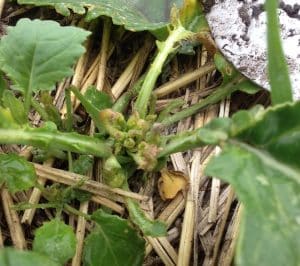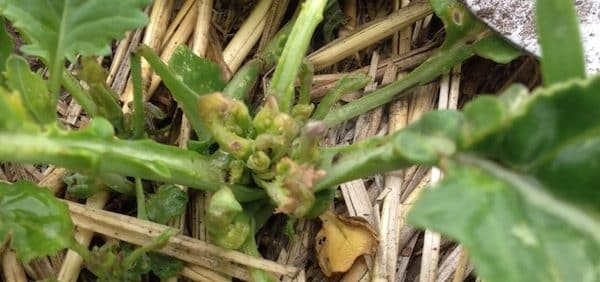
Herbicide damage to canola can take many forms. Here are some clues to look for:
Misshapen growth
—Odd growth patterns may be the result of herbicide residues in the tank that are toxic to canola. Look for stunted growth on leaves and roots, leathery leaves, twisted stems, clumpy root hairs or otherwise odd root development. These symptoms can also result from herbicide carryover in the field. Dry conditions will reduce the breakdown of last year’s herbicide, increasing the risk from carryover damage.
Dead plants on one side of the field only
—This is a clear sign of drift from a neighbouring field.
Patterns in the field
—Look for damage that starts off severe then gets progressively less and finally ends after a few sprayer passes. This indicates something left over in the booms and filters that was sprayed out within the first few passes.
—Patterns that clearly relate to this year’s sprayer passes are caused by sprayer contamination, spray conditions or product selection issues. If damage is across the whole field but is lower in corners where the boom moved faster and deposited less product or is lower (or non existent) in sprayer misses, this indicates a spray tank contamination that affected the whole load.
—Patterns that follow field topography — if hilltops are worse than lower high-moisture areas, for example — are more typical of carryover damage (residue in the soil from previous applications).
Contamination can get worse with the second load (An example)
Situations have been reported in diagnostic cases where the first tank of Liberty applied to a Liberty Link canola field is undamaged whereas subsequent tank loads suffer from sub-lethal damage from Group 2 herbicide. In each progressive tank load the damage is less severe than the previous until it is no longer visible. The cause of this is likely the way that mixing occurred. With a contaminated sprayer, the removal of the contamination in any significant amount would not occur until a strong cleansing agent (i.e. Liberty or an adjuvant like Merge) is introduced to the sprayer. If the for the first tank load, the cleansing agent is not added until the last minute before that tank is used, not enough of the contaminant is removed during the spray operation to result in significant injury. But when the sprayer returns to load the second tank and the agitation is shut off while the tank fills, the relatively concentrated cleansing agent has an extended period of contact with the main circulatory system of the sprayer including the main in-line screens. This extended contact allows a significant amount of the contaminant to be removed from the plumbing of the sprayer and when the agitation is started again prior to application, the contaminant is spread throughout the entire load. The amount of the contaminant in the spray solution is not high enough to kill the plant, but it is sufficient to produce sub-lethal symptoms and significantly reduce yield and delay maturity.
Because the operator does not realize this is happening, the process repeats itself continually until the contamination is gone.
In another case, the solution containing a cleansing agent was left in the tank after shutting down for the evening after spraying a part of a field. When spraying resumed the next morning, all of the contaminant had been liberated from the interior of the sprayer. That last part of the first tank load resulted in catastrophic damage to the crop, even though no damage was reported from the application the night before. Subsequent tanks showed no injury, as the cleansing agent had removed the majority of the contaminant form the sprayer.
—Thanks to Clark Brenzil, Saskatchewan Ministry of Agriculture, for this example.
A residue test. Some labs will test damaging tissue for herbicide residue. Some labs will do soil bioassays to check for damaging levels of residue. Find those labs here. Check with each lab for directions on how to properly collect and deliver samples. To try your own soil bioassay, gather soil from various parts of the field and put it into a pot. Seed canola or some extra sensitive crop like beets into that soil. Look for damage as plants emerge and grow. This will indicate the presence o herbicide residue, but it won’t tell you when residue entered the soil.
Further reading:
How to prevent sprayer contamination
To identify herbicide carryover by the damage done, read “Recognizing herbicide residue and drift injury in canola”

